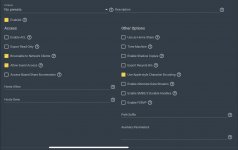It has been discussed in the past, but on the actual scale system in combination with windows, I simply do not manage 
What I like to archive is a SMB-share which is accessible without any username or password, from a user-pc is within a certain vlan.
So:
- I defined a dataset 'guests' and
- I defined a smb share 'guests' pointing to the dataset
- share of ^type^ 'no presets' (IMHO they are just confusing)
- options Enable ACL; Browsable to Network Clients ; Allow Guest Access
- Host Allow: the IP-ranges which should have access
- Other options: Enable Shadow copies; Enable Alternate Data Streams; Enable SMB2/3 Durable Handles
I doubt if I should 'Enable SMB2/3 Durable Handles', to be honest I think not. I also think it is hardly relevant.
The impact of the following options are not at all clear to me:
- Enable ACL (which ACL's ?? and what are the consequences ??) and
- Allow Guest Access (what does it do !??; Is it truenas is it windows ??)
After(!!) defining this we find in the SMB share menu two sets of ^ACL's^
- Share ACL's which seems to be intended to set windows permissions and
- a bit strange to find that option here, a rather complex menu to set dataset permissions
It is not really clear to me. There is some explanation here:

 www.truenas.com
www.truenas.com
Since I do not intent to influence windows authorization, I did leave the ^Share ACL's^ at default.
And in principle I do not want to use the (IMHO hardly understandable) Unix ACL editor as well,
since I all ready did define the authorization in the dataset-menu.
So assume we defined the permissions for the dataset as:
owner rwx; group rwx; other rwx
Permission wise that would do, since we intent to allow every one (being in a certain network) to use the share.
However, we also want:
- that there is no logon
- and the user should not / is not known by truenas
So I have been thinking about adding 'nobody' as authorized for the dataset.
However:
- I did not manage to do that and
- I did not manage to get rid of the windows logon screen
So I hope someone knows the solution.
Louis
PS. I have considered defining a user 'guest' with password 'guest' as work around, but for multiple reasons among which security, I do not like that.
What I like to archive is a SMB-share which is accessible without any username or password, from a user-pc is within a certain vlan.
So:
- I defined a dataset 'guests' and
- I defined a smb share 'guests' pointing to the dataset
- share of ^type^ 'no presets' (IMHO they are just confusing)
- options Enable ACL; Browsable to Network Clients ; Allow Guest Access
- Host Allow: the IP-ranges which should have access
- Other options: Enable Shadow copies; Enable Alternate Data Streams; Enable SMB2/3 Durable Handles
I doubt if I should 'Enable SMB2/3 Durable Handles', to be honest I think not. I also think it is hardly relevant.
The impact of the following options are not at all clear to me:
- Enable ACL (which ACL's ?? and what are the consequences ??) and
- Allow Guest Access (what does it do !??; Is it truenas is it windows ??)
After(!!) defining this we find in the SMB share menu two sets of ^ACL's^
- Share ACL's which seems to be intended to set windows permissions and
- a bit strange to find that option here, a rather complex menu to set dataset permissions
It is not really clear to me. There is some explanation here:

Managing SMB Shares
Provides information on how to manage Server Message Block (SMB) shares on your TrueNAS.
Since I do not intent to influence windows authorization, I did leave the ^Share ACL's^ at default.
And in principle I do not want to use the (IMHO hardly understandable) Unix ACL editor as well,
since I all ready did define the authorization in the dataset-menu.
So assume we defined the permissions for the dataset as:
owner rwx; group rwx; other rwx
Permission wise that would do, since we intent to allow every one (being in a certain network) to use the share.
However, we also want:
- that there is no logon
- and the user should not / is not known by truenas
So I have been thinking about adding 'nobody' as authorized for the dataset.
However:
- I did not manage to do that and
- I did not manage to get rid of the windows logon screen
So I hope someone knows the solution.
Louis
PS. I have considered defining a user 'guest' with password 'guest' as work around, but for multiple reasons among which security, I do not like that.

